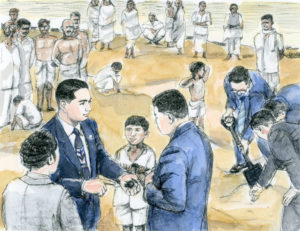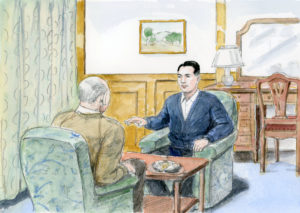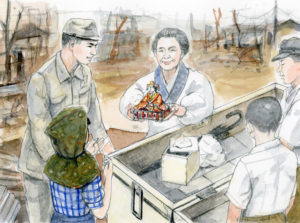Chapter Summary

Illustration courtesy of Seikyo Press.
The following morning, Shin’ichi Yamamoto and his fellow leaders went to the banks of the Ganges River where they had a spontaneous and heartwarming exchange with children living under the pressing weight of poverty. Shin’ichi thought about Josei Toda’s earnest wish for the peace and prosperity of all people, and felt the weight of the mission and responsibility that rested on his shoulders.
After visiting more sites and museums, the group ended their eight-day sojourn in India and left for Burma on February 7.
On the plane, Shin’ichi thought of his eldest brother, Kikuo, who had died in Burma during World War II, and chanted for him and all who had lost their lives during the war. The next day, they visited a Japanese cemetery in Rangoon (present-day Yangon) to conduct a memorial service in Kikuo’s honor at the monument dedicated to fallen soldiers.
Shin’ichi recalled memories of Kikuo: the time he and Kikuo each took a piece of a broken mirror from his mother’s trousseau; when Kikuo came home for a short leave and recounted the horrors of war; the sight of his mother racked by sobs when she received news of her eldest son’s death.
His prayers for the peaceful repose of the fallen soldiers turned into a powerful pledge to build lasting peace.
After Burma, they went on to Thailand and Cambodia. Observing the scars of war left by the Japanese military throughout Asia, Shin’ichi determined as a Japanese citizen to pave the path for happiness and peace. He shared his vision to open a research institute for philosophy, culture and ethnic studies, as well as an institution dedicated to musical and cultural exchange.
Having successfully concluded this first trip to Asia, they departed for Japan on February 14.
Unforgettable Scene

Illustration courtesy of Seikyo Press.
Development Stems From Encouragement
On February 5, 1961, the group travels to Calcutta, where at the hotel Shin’ichi runs into an acquaintance from Japan.
After checking in, the group went to dinner at a Chinese restaurant. Later that evening, an elderly Japanese entrepreneur who happened to be staying at the same hotel stopped by Shin’ichi’s room. The man had been a good friend of Josei Toda, and Shin’ichi also knew him well. Their conversation turned to reminiscences.
“Mr. Yamamoto, wouldn’t you say that Mr. Toda’s greatness lay in building the organizational framework of the Soka Gakkai? I don’t think it would have developed to this extent otherwise. This is the age of the organization. Where there is a solid organization, expansion and growth will follow.”
Shin’ichi said: “That may certainly be true in one respect, but it isn’t the only factor. Organizations are everywhere. Companies, labor unions—they are all organizations. Organizing has its advantages and disadvantages. The more established an organization is, the more rigid and bureaucratic it tends to become.”
■ ■ ■
[Shin’ichi continued:] “President Toda’s greatness, I believe, lay in his continually infusing the organization with fresh life by tirelessly pumping the lifeblood of human warmth through its veins.
Practically speaking, he did this by offering encouragement and guidance to each member … “The Soka Gakkai’s development stems solely from its having provided encouragement to people in their darkest hours—when, for many, the suffering was so overwhelming that suicide seemed the only answer—and helping them resume their lives with courage again through faith.
“The members didn’t love Mr. Toda because he was president. Their profound respect for him came from their personal experiences of opening their lives and becoming happy as a result of his guidance and his encouragement.” (The New Human Revolution, vol. 3, revised edition, pp. 233–34)

Illustration courtesy of Seikyo Press.
Memories of Japanese Dolls
During their visit to Burma (Myanmar), Shin’ichi recalled his oldest brother, a Japanese army soldier who died there during World War II, as well as memories of his mother and family during the war.
One episode in particular illustrates his mother’s inner strength. Toward the end of the war, the family’s house in Kojiya, Kamata Ward, had been designated for demolition to clear a firebreak to prevent fires caused by air raids in one sector from immediately engulfing neighboring areas. They were served a compulsory evacuation notice. Faced with no alternative, they decided to have an extra wing built onto a nearby relative’s house and move in there. They had just transferred all their things into their new home and were preparing to take up residence the very next day, when the air raids started. Their new home sustained a direct hit from an incendiary bomb and burned to the ground. All they managed to save was a single storage chest.
The next morning, stunned, they sifted through the rubble. All their personal belongings had been reduced to ashes except for the storage chest. Not sure what was inside, everyone turned to it with anticipation. When they opened it, however, they were dumbstruck. All it contained was a set of Japanese dolls, the type displayed once a year during the Girls’ Festival. Lying next to it, almost apologetically, was an umbrella. Other than that, the chest was empty.
Shin’ichi and his younger brother had managed to rescue it from their burning house with much physical effort and at considerable personal risk. Now, seeing the contents, Shin’ichi felt his energy drain out of him.
They all gazed at the dolls with hollow looks of resentment. Then Shin’ichi’s mother said, “I bet we’ll soon be living in a house where we can display these dolls again!”
She must have been as disappointed as the rest of the family, but she made an effort to be bright. They were cheered by her resolute spirit and felt a surge of courage. Their laughter rang out across the charred landscape. Burning within her heart was a powerful, indomitable fighting spirit. (NHR-3, revised edition, 259–60)
The chapter summary was originally published in the December 5, 2018, Seikyo Shimbun, while the “Unforgettable Scene” was originally published in the December 12, 2018, issue.
Key Passage
When disciples have a seeking spirit toward their mentor and determine to fight alongside him, then the mentor’s life—the mentor’s commitment to kosen-rufu—pulses and flows through the disciples’ veins. (NHR-3, revised edition, 291)
You are reading {{ meterCount }} of {{ meterMax }} free premium articles

